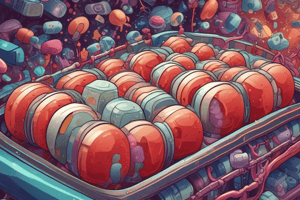Podcast
Questions and Answers
What is the main mechanism of action of aminoglycosides?
What is the main mechanism of action of aminoglycosides?
- Inhibition of protein synthesis by binding to 50s subunits
- Binding to 30s subunits leading to altered anticodon sequence of tRNA (correct)
- Inhibition of DNA replication by binding to DNA polymerase
- Inhibition of cell wall synthesis by binding to peptidoglycan
Why are aminoglycosides not administered orally?
Why are aminoglycosides not administered orally?
- Due to their poor gastrointestinal absorption (correct)
- Due to their rapid degradation in the gut
- Due to their low bioavailability
- Due to their high toxicity
What is the primary reason for reserving aminoglycosides for severe systemic infections?
What is the primary reason for reserving aminoglycosides for severe systemic infections?
- Their low efficacy against Gram-positive bacteria
- Their potential for resistance development
- Their high toxicity profile (correct)
- Their narrow spectrum of activity against Gram-negative bacteria
What is the primary mechanism of resistance to aminoglycosides?
What is the primary mechanism of resistance to aminoglycosides?
What is a common adverse effect of aminoglycosides?
What is a common adverse effect of aminoglycosides?
At which ribosomal binding site does Clindamycin bind?
At which ribosomal binding site does Clindamycin bind?
What is the effect of Clindamycin on toxin production by GAS and S. aureus?
What is the effect of Clindamycin on toxin production by GAS and S. aureus?
What is the activity of Clindamycin against staphylococci and streptococci?
What is the activity of Clindamycin against staphylococci and streptococci?
What is the class of antibiotics that Clindamycin belongs to?
What is the class of antibiotics that Clindamycin belongs to?
What is the activity of Clindamycin against anaerobes?
What is the activity of Clindamycin against anaerobes?
Flashcards are hidden until you start studying
Study Notes
Aminoglycosides
- Bactericidal antibiotics that bind to 30S subunits, altering the anticodon sequence of tRNA
- Mainly effective against Gram-negative bacilli and Staphylococcus species
- Administered systemically, primarily via intramuscular (IM) injection
- Not administered orally (except for neomycin) due to poor gastrointestinal absorption
- May cause ototoxicity, nephrotoxicity, and respiratory depression
- Reserved for severe systemic Gram-negative infections
- Excreted in the urine, requiring dosage adjustment
- Effective in topical ophthalmic use, but only for short-term therapy (5-7 days)
Mechanisms of Resistance
- Alteration of 30S subunit binding site
- Change in cell membrane permeability
- Enzymatic inactivation
Adverse Effects
- Vestibular and auditory dysfunction
- Nephrotoxicity (tubular necrosis)
- Respiratory depression (neuromuscular paralysis)
Clindamycin
- Lincosamide class of antibiotics
- Binds to 50S ribosomal binding site, similar to macrolides
- Inhibits production of toxic-shock and other toxins by GAS and S. aureus at low concentrations
- Exhibits concentration-dependent bactericidal activity against:
- Staphylococci
- Streptococci
- Anaerobes
- H. pylori
- Bacteriostatic agent, but can be bactericidal at high concentrations
Studying That Suits You
Use AI to generate personalized quizzes and flashcards to suit your learning preferences.




